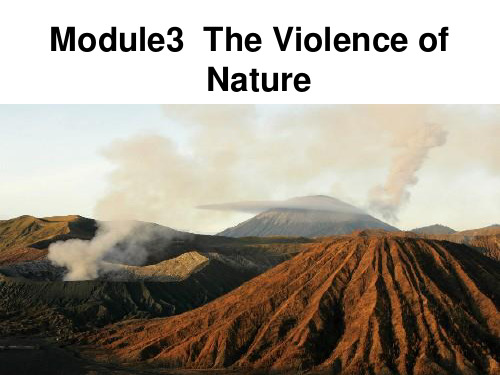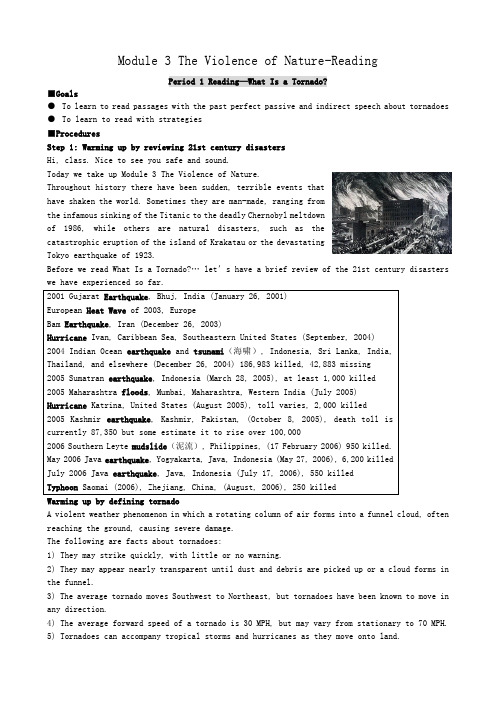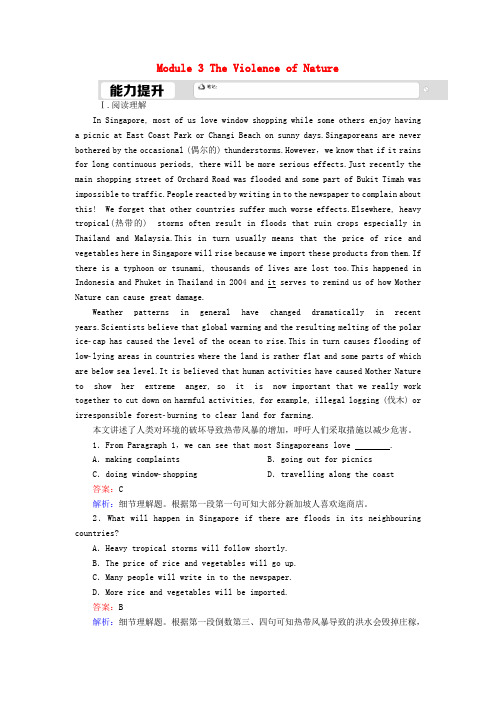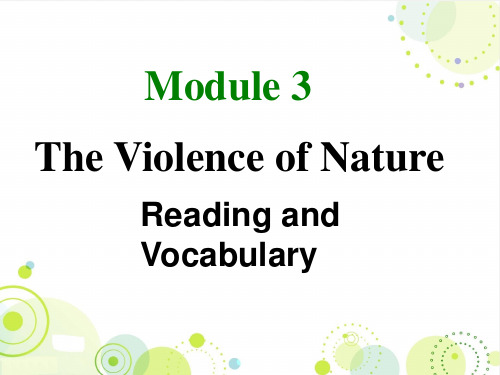Module3 The Violence of Nature reading
- 格式:ppt
- 大小:1.96 MB
- 文档页数:29


Module 3 The Violence of Nature-ReadingPeriod 1 Reading—What Is a Tornado?■Goals●To learn to read passages with the past perfect passive and indirect speech about tornadoes ●To learn to read with strategies■ProceduresStep 1: Warming up by reviewing 21st century disastersHi, class. Nice to see you safe and sound.Today we take up Module 3 The Violence of Nature.Throughout history there have been sudden, terrible events thathave shaken the world. Sometimes they are man-made, ranging fromthe infamous sinking of the Titanic to the deadly Chernobyl meltdownof 1986, while others are natural disasters, such as thecatastrophic eruption of the island of Krakatau or the devastatingTokyo earthquake of 1923.Before we read What Is a Tornado?… let’s have a brief review of the 21st century disasters we have experienced so far.Warming up by defining tornadoA violent weather phenomenon in which a rotating column of air forms into a funnel cloud, often reaching the ground, causing severe damage.The following are facts about tornadoes:1) They may strike quickly, with little or no warning.2) They may appear nearly transparent until dust and debris are picked up or a cloud forms in the funnel.3) The average tornado moves Southwest to Northeast, but tornadoes have been known to move in any direction.4) The average forward speed of a tornado is 30 MPH, but may vary from stationary to 70 MPH.5) Tornadoes can accompany tropical storms and hurricanes as they move onto land.6) Waterspouts are tornadoes that form over water.7) Tornadoes are most frequently reported east of the Rocky Mountains during spring and summer months.8) Peak tornado season in the southern states is March through May; in the northern states, it is late spring through early summer.9) Tornadoes are most likely to occur between 3 p.m. and 9 p.m., but can occur at any time.Step 2: Before you readPlease go over the word list for this module, paying attention to the pronunciation of the word, the relationship between its pronunciation and its spelling.Step 3: While you read1. Type of writing and summaries of What Is a Tornado2. A diagram of What Is a Tornado3. Complete the article with one word in each blankWhat Is a Tornado? Being a rotating _1_ of air from a thunderstorm to the ground tornados almost occur in the US, in the _2_from Texas in the southeast to South Dakota in the north.What Is a Hurricane? Being strong _3_ storms, hurricanes usually occur in the southern Atlantic Ocean, the Caribbean Sea and the Gulf of Mexico. There are _4_ winds of 120 kilometers per hour or more, which _5_ huge waves, heavy rain and floods.Here is an Extraordinary Event. This is a story _6_ the 1900 Galveston hurricane.Charles Coghlan, a nineteenth-century Irish actor. He died in 1899. _7_ years later, his coffin was found by fishermen in the sea near his home. The Gulf Stream had _8_ it 3,000 kilometers up the eastern US coast to Prince Edward Island.4. Answer the reading comprehension questions according to the text1. On average, there are ____tornadoes in the US each year, causing about _____deaths and _____ injuries.A. 700, 70, 1400B. 800, 80, 1500C. 600, 60, 1300D. 800, 85, 15502. The most violent tornados have winds of more than _____ kilometers per hour.A. 400B. 500C. 600D. 7003. There are on average _____ Atlantic hurricanes each year and they usually affect the east coast of the _____ from Texas to Maine.A. five, BritainB. six, USC. seven, ChinaD. eight, Japan4. The cemetery _____ Coghlan was buried was destroyed by the hurricane and Coghlan’s coffin ______ up in the sea.A. which, costB. when, lostC. where, endedD. that, cameStep 4: After you read1. Copy all the useful expressions into your Expression Book. If possible, make your own sentences with these expressions.2. Read to transfer information。


Module 3 The Violence of NatureⅠ.阅读理解In Singapore, most of us love window shopping while some others enjoy having a picnic at East Coast Park or Changi Beach on sunny days.Singaporeans are never bothered by the occasional (偶尔的) thunderstorms.However,we know that if it rains for long continuous periods, there will be more serious effects.Just recently the main shopping street of Orchard Road was flooded and some part of Bukit Timah was impossible to traffic.People reacted by writing in to the newspaper to complain about this! We forget that other countries suffer much worse effects.Elsewhere, heavy tropical(热带的) storms often result in floods that ruin crops especially in Thailand and Malaysia.This in turn usually means that the price of rice and vegetables here in Singapore will rise because we import these products from them.If there is a typhoon or tsunami, thousands of lives are lost too.This happened in Indonesia and Phuket in Thailand in 2004 and it serves to remind us of how Mother Nature can cause great damage.Weather patterns in general have changed dramatically in recent years.Scientists believe that global warming and the resulting melting of the polar icecap has caused the level of the ocean to rise.This in turn ca uses flooding of lowlying areas in countries where the land is rather flat and some parts of which are below sea level.It is believed that human activities have caused Mother Nature to show her extreme anger, so it is now important that we really work together to cut down on harmful activities, for example, illegal logging (伐木) or irresponsible forestburning to clear land for farming.本文讲述了人类对环境的破坏导致热带风暴的增加,呼吁人们采取措施以减少危害。

Book 3 Module 3 The Violence of NatureReadingI.背景知识:一、(Natural disaster/Natural hazard)“自然灾害”是人类依赖的自然界中所发生的异常现象,自然灾害对人类社会所造成的危害往往是触目惊心的。
它们之中既有地震、火山爆发、泥石流、海啸、台风、洪水等突发性灾害;也有地面沉降、土地沙漠化、干旱、海岸线变化等在较长时间中才能逐渐显现的渐变性灾害;还有臭氧层变化、水体污染、水土流失、酸雨等人类活动导致的环境灾害。
这些自然灾害和环境破坏之间又有着复杂的相互联系。
人类要从科学的意义上认识这些灾害的发生、发展以及尽可能减小它们所造成的危害,已是国际社会的一个共同主题。
中国自然灾害种类繁多。
地震、台风、暴雨、洪水、内涝、高温、雷电、大雾、灰霾、泥石流、山体滑坡、海啸、道路结冰、龙卷风、冰雹、暴风雪、崩塌、地面塌陷、沙尘暴等等,每年都要在全国和局部地区发生,造成大范围的损害或局部地区的毁灭性打击。
二、(Tornado, hurricane and typhoon)飓风和台风都是指风速达到33米/秒以上的热带气旋,只是因发生的地域不同,才有了不同名称。
出现在西北太平洋和我国南海的强烈热带气旋被称为“台风”;发生在大西洋、加勒比海和北太平洋东部的则称“飓风”。
飓风在一天之内就能释放出惊人的能量。
飓风与龙卷风也不能混淆。
后者的时间很短暂,属于瞬间爆发,最长也不超过数小时。
此外,龙卷风一般是伴随着飓风而产生。
龙卷风最大的特征在于它出现时,往往有一个或数个如同“大象鼻子”样的漏斗状云柱,同时伴随狂风暴雨、雷电或冰雹。
龙卷风经过水面时,能吸水上升形成水柱,然后同云相接,俗称“龙取水”。
经过陆地时,常会卷倒房屋,甚至把人吸卷到空中。
II.在课文中标出下列单词、短语和它们的含义。
1. Texas 得克萨斯州2. South Dakota美国南达科他州3. Missouri 密苏里州4. Illinois 伊利诺伊州5. Indiana 印第安纳州6. the Atlantic Ocean 大西洋7. the Caribbean Sea 加勒比海8. the Gulf of Mexico 墨西哥湾9. Maine 缅因州10. Galveston 加尔维斯顿11. Charles Coghlan 查尔斯.科格伦12. Irish 爱尔兰13. Prince Edward Island 爱德华王子岛课上学案Reading comprehension 阅读理解I. Read What is a Tornado? and try to decide if these sentences are True or False. If they are false, please correct them.(判断正误并改错,并从文中找到对应点)①A tornado is a rotating column of air from a thunderstorm to the ground. ( )②The most violent have winds of 4000 kilometres per hour. ( )③Tornadoes can pick up cars ,trains and even houses and put them down in the next street –or even in the next town. ( )④They can take the feathers off a chicken, but they could n’t destroy houses. ( )⑤On average, there are 800 tornadoes in the UK each year, causing 80 deaths and 1500 injuries. ( )⑥The worst tornado was in 1925 and it killed 2700 people. ( ) II. Read What is a hurricane? and try to answer the following questions .1)What is a hurricane and where do they occur?2) What happens at sea during a hurricane?3) When was the worst hurricane and how many people died in it?B3 Module 3 The Violence of NatureLearning Plan 1 The Gulf Stream &What is a Tornado?目标和要求: 1. 明确词汇的汉语意思、准确读出、并能默写出。

Module3 The Violence of Nature说课(Reading&Vocabulary)一、Analysis of teaching material [əˈnæləsɪs]The content of this course is selected from the third and third compulsory module of Senior English Foreign Studies Institute. This lesson takes "Nature Disaster" as the topic, explains what tornadoes and hurricanes are, and describes the harm they bring to people. Students learn to acquire the details of the material through reading, understand the hazards of natural disasters as well as their experiences and feelings in natural disasters, and improve their self-protection awareness.二、Analysis of Learning SituationThe object of instruction is the students of Class 8 Grade One of Senior High School. The students in this class are extroverted, open-minded and active. Most of the students are below the middle level. These students are relatively enthusiastic and hard-working, but their English foundation is weak and their vocabulary is small. On the whole, some students in this class can extract and process information in English, and simply express their views. However, their ability to consistently describe events, interpret meanings and critically evaluate in English is weak.三、Teaching goals1.Enable the students to get the main idea of the text , sorte out the structure of the article, and summarize the factual information about the Nature Disaster.2.Learn how to describe natural disasters with useful expressions and sentences.3.By discussing some natural disasters and reading the passages, lead the students to learn about the rescue skills once a disaster happens.四、Teaching important and difficult pointsHelp the students to get the main idea of the text , sorte out the structure of the article, and summarize the factual information about the Nature Disaster .Learn to how to talk about natural disasters .五、Teaching methodsTalking method, skimming, scanning and Pair work / Group work.六、Teaching procedures & waysStepI Lead-in1. Ss are asked to watch a vedio about a Hurricane which happened in the eastern United States.2.Ss are encouraged to name as many natural disasters as possible.3.Then Ss work in pairs ,Talk about a natural disaster they have experienced.(设计意图:利用视频和图片,创设语境,导入本节课的话题“ natural disasters”,激活学生已有的关于自然灾害的认知和经验。
外研版高一年级(必修3)Module 3tornado hurricaneGet the main idea:■Part 1: What is a tornado?■Part 2:What is a hurricane?■Part 3: An extraordinary eventRead the three passages quickly and fill in the blanks.A tornadoA huiricaneAn extraordinary eventA tornado!• A tornado is 力rnhitirig cnhimnnf Mrfrom a thunderstorm to the ground> The most violent have winds of morethan 400 kilometresper hour>2. They occur in the area of fromTe 咒岔s in the sou the 岔sttoSouth Dmko" in the north •3・ They can pick npcars.trains and houses.They can destroy houses, but leave thefurniture inside exactly where it was.4. The worst one occurred in 1925, affectingthree US shdes・More than 700 people had been killed and 2,700 had been injured.A hurricane1・ Hurricanes are strong tropical storm®2. They occur in the southern Atlantic Ocean,the Caribbean Sea and theGulf of Mexico •3. The worst one occurred on the8th September 1900 in Galveston,Texas. It killed 6,000 peopleAn extraordinary eventCoghlan went to live in Canada・—He then moved to New York-^Galveston—>(his coffin)—>Prince Edwnrd Island in Canada.True or False.X 1・ All tornadoes have winds of more than 400 kilometres per hour.J 2・ There are more tornadoes occurring in the US than in other parts of theworld・X 3・ Tornadoes carft destroy furniture because they are not violent enough・X 4・ In the US, there are usually about 80 people killed in tornadoes everyyear.\J 5. The worst tornado in history killed at least 700 people.X 6・ Every year there are six Atlantic hurricanes ・J 7・ Both the worst tornado and theworst hurricane occurred in the US.X 8. The worst hurricane of all time killed about one-sixth of the population inthe US.^/9・Charles Coghlan didn't become famous until he moved to New York. X 10・ Coghlan9s coffin was destroyed by the 1900 Galveston hurricane・X 11 ・ It was only because of thehurricane that CoghlarTs body couldtravel back to Canada・Match the words with their definitions.1.you an see this on an animal・2.describe the hottest parts ofthe earth, north and souththe equator・3・ a terrible event 4. you cansee t5・ toplace prthe feathers tropical ccur furury disasground ortom6. to happe2. Almost all of them occur in the US,…几乎所有的龙卷风都发生在美国。